mobile View, to the German Version tap the flag


- Carniola (Krain), Slovene: Kranjska
- former Austrian crown land: Duchy of Carniola
- today central countryside of Slovenia
• Flags
• Meaning/Origin of the Flag
• Coat of Arms
• Meaning/Origin of the Coat of Arms
• Map of the former crown lands of Austria-Hungary (to 1918)
• historical Maps of Carniola
• Numbers and Facts
• History
• Origin of the Country's Name
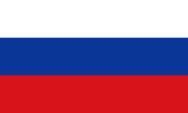
1848–1919,
Flag of the country (Colours of the country),
ratio = 2:3,
Source, by:
Wikipedia (EN)



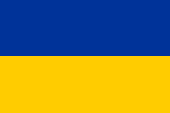
to 1848,
Flag of the country (Colours of the country),
Source, by:
Wikipedia (D)





The country had – like all the other crown lands of the Austrian crown – its own colours (Landesfarben), which were used amongst others on horizontally two- or three-striped flags. The colours (Landesfarben) were very often taken from the respective coat of arms of the country or were supplemented by another colour, which not appears in the coat of arms, or they went back to older models of the coat of arms (e.g. Carniola). Officially, the colours had never been regulated or stipulated, so that their sequence varied in practice or even the colors deviated. The Austrian heraldist Hugo Gerard Ströhl (1851–1919) was probably the first to take care of it and asked for the colors (Landesfarben) on the flags at the respective state authorities around 1890 and compiled them.
The Duchy of Carniola used as colours of the country initially the colours blue and gold. The colours descend from the coat of arms of Carniola from the 16th century. In 1836, Emperor Ferdinand I. of Austria restored the country's coat of arms in its original colours with the silvery shield. The colors of the country remained unchanged in blue and gold. On the initiative of the commander of the National Guard in Laibach (Ljubljana), of the Slovenian Association and of several Carniolan Reichstag deputies, new national colors were created in 1848. On the flag they were arranged as three horizontal stripes in white, blue and red. The Ministry of the Interior of the Austrian Empire recommended on 23rd of September in 1848 (petition, file number Z. 2778), that the colors have to be adopted, but only if the coat of arms and the seal remained unchanged and no other rights were derived from that. The Illyrian State Presidium implemented the decision on 29th of September in 1848 by law (file number Z. 241/P), which was announced in the official gazette "Laibacher Zeitung" from 3rd of October in 1848, page 599. On the one hand, the Carniolans adopted the colors of the Duchy of Carniola from the time before 1463 as theirs, on the other hand they adopted a flag in the "Pan-Slavic Colours" – an exact copy of the Russian flag. Carniola is the heartland of today's Slovenia, which uses these colors until today.
Source: Wikipedia (D),
Wikipedia (EN),
Österreichisch-Ungarische Wappenrolle


to 1463,
Blazon of Carniola,
Source, by: Wikipedia (D)

1463–1836,
Blazon of Carniola,
Source, by: Wikipedia (D)
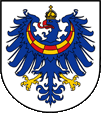
1836–1919,
Blazon of Carniola,
Source, by:
Wikipedia (EN)
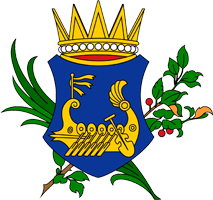
1816–1849,
Carniola belongs to the Habsburg Kingdom of Illyria,
Source, by: Ströhl, Wappenrolle Österreich-Ungarns, 1890, via Wikipedia (D)
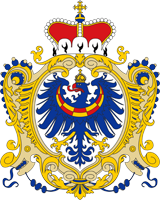
ca.1890–1918,
Coat of arms of the Duchy of Carniola,
Source, by: Ströhl, Wappenrolle Österreich-Ungarns, 1890, via Wikipedia (D)

The coat of arms of Carniola showed originally a blue eagle with red arms on a silvery shield, on it a ten-times in red and gold checkered crescent (also called barrette). In 1463, the coat of arms was changed at the behest of Emperor Frederick III. The Carniolans helped Emperor Friedrich III. in 1462 when he was besieged in Vienna Castle by his brother Albrecht VI. In thanks, he improved the coat of arms of the duchy. The coat of arms of Carniola now showed a blue eagle with red arms on a golden shield. The colors of the checkered crescent changed to red and gold and the eagle wears a crown. In 1836, Emperor Ferdinand I. of Austria restored the country's coat of arms in its original colours with the silvery shield. As an Habsburg crown land the coat of arms showed above a princely hat.
Source: Wikipedia (D),
Wikipedia (EN),
Österreichisch-Ungarische Wappenrolle

Map ca. 1910:
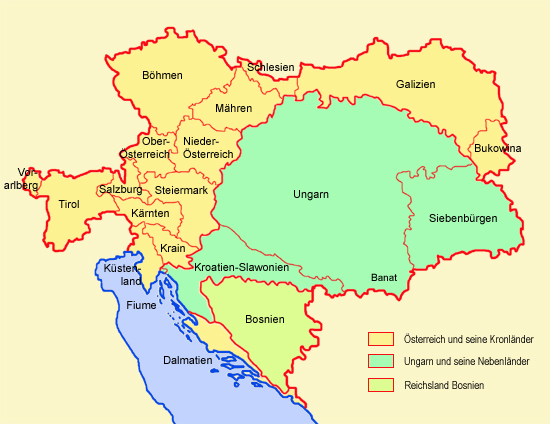
Source: Volker Preuß

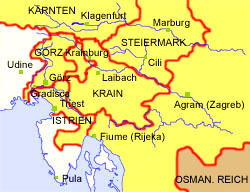
ca. 1526
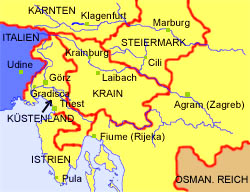
1849
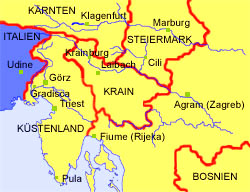
1880
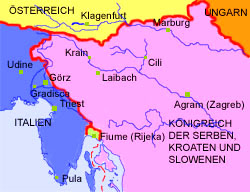
1921
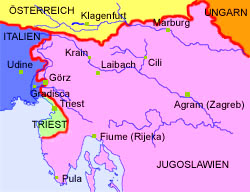
1950
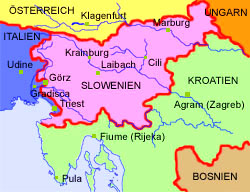
2005
Map: Volker Preuß

Area: 3.878 square miles (1880)
Inhabitants: 481 250 (1880), thereof 92% Slovenes, 6% Germans, 2% Croats
Density of Population: 124 inh./sq.mi. (1880)
Capital: Laibach (today's name: Ljubljana), 26.284 Ew. (1880), 284.355 Ew. (2019)
Sprachen (1880): Slovene, German
Currency: to 1918 Austrian currency, since 1918 Yugoslav currency, since 1941 German/Italian currency, since 1945 Yugoslav currency, since 1991 Slovanian currency
Time Zone: GMT + 1 h
Source: Meyers Konversationslexikon,
Time Zonen.de

ca. 15 A.D. · the conquest of today's Carniola by the Roman Empire is finished, to the Province of Pannonia Superior
395 · at the partition of the Roman Empire Carniola comes to the West Roman Empire (Rome)
476–489 · Carniola belongs to the Empire of the Odoaker
489–553 · Carniola belongs to Empire of the Eastern Goth
6th cent. · settlement by Slavic tribes
569–598 · conquest by the Awars
ca. 800 · the today's Carniola becomes subjected by the Frankish Empire of the Carolingians, formation of the "Mark Krain", administration by the Margrave and Duke of Friaul
934 · the Mark Krain (Carniola) comes to Bavaria
976 · Carniola comes to the Duchy of Carinthia
1394 · Carniola (incl. Istria) becomes an own Duchy of Habsburg
1797–1809 · French Revolutionar Wars, parts of Austria (Styria) become occupied by the French in 1797
1809 · Peace of Vienna, Austria loses Salzburg, the Inn Quarter, Western Galicia and parts of Eastern Galicia and cedes Istria, Trieste, Gorizia, Carniola, Carinthia, Croatia, and Dalmatia to France, which were merged in 1810 to the French "Illyrian Provinces"
1813 · Austria declares war on France (Napoléon)
1814/1815 · Congress of Vienna, realignment of Europe after the era Napoléon, the Empire of Austria (House of Habsburg) acquires back the in 1809 lost territories, they become merged to the Habsburg's Kingdom of Illyria, Carniola becomes a part of the Habsburg's Kingdom of Illyria, Dalmatia and Croatia become re-annexed to Hungary (under the Habsburgs, part of the Empire of Austria)
1848/1849 · revolution in Vienna, civil war between Hungarians and Croats, riotings in Prague, Mailand and Venice, as a result of that Emperor Ferdinand I. resigns and Franz Joseph I. of Habsburg becomes new Emperor, the riotings become suppressed and he enacts a new constitution: the titular hereditary territories of the Habsburgs in the Austrian Empire become converted to crown lands with their own Landtag (parliament), the Landtag of Dalmatia rejects the annexion to Croatia, the Kingdom of Dalmatia becomes an own crown land of the Austrian crown, Croatia and Slavonia become united to the "Kingdom of Croatia and Slavonia", which remains as a subsidiary country under the Hungarian crown, dissolution of the Kingdom of Illyria: division in the crown lands of Carniola, Carinthia, Littoral, Croatia and Slavonia and Dalmatia
1914–1918 · First World War, thereafter breakdown of the imperial-royal monarchy, disintegration of Austria-Hungary in national states
10th of September 1919 · Treaty of Peace of Saint-Germain after the First World War, Austria has to cede Carniola and parts of Carinthia and Steiermark to the "Kingdom of the Serbs, Croats and Slovenes" (since 1929 named Yugoslavia), Carniola becomes the heartland of the District of Drau (later Slovenia)
1939–1945 · Second World War, Yugoslavia is between 1941 and 1946 location of a merciless partisan and civil war between communists (under J.P.Tito), republicans, monarchists and nationalists, the communists had exulted
6th of April 1941 · invasion of German and Italian troops
17th of April 1941 · capitulation of Yugoslavia, Yugoslavia becomes dissolved: the King escape into the exile, some territories have to cede to neighbouring states (Macedonia, Kosovo, Banat and Slovenia), the Province of Bosnia-Hercegovina gets incorporated into Croatia, Croatia and Montenegro get independent, Serbia comes under German military administration, the District od Drau becomes partitioned between the German Empire (northern part) and Italy (southern part)
13th of October 1943 · capitulation of Italy, as a result of that occupys Germany among other also the southern part of Slovenia, the "Province of Laibach / Ljubljanska Pokrajina"
19th of February in 1944 · founding of Federal Slovenia by the communist resistance
1945 · conquest and occupation of the area by Yugoslav partisans, expulsion and partially even assassination of the largest part of the in the country remained German civilian population
29th of November 1945 · proclamation of the "Federative People's Republic of Yugoslavia" by Tito
31st of January in 1946 · founding of the People's Republic of Slovenia
7th of April in 1963 · proclamation of the Socialist Republic of Slovenia (within communist Yugoslavia)
8th of March in 1990 · proclamation of the Republic of Slovenia
25th of June 1991 · Slovenia declares its independence from Yugoslavia
Source:
Atlas zur Geschichte,
Wikipedia (D),
Meyers Konversationslexikon,
Discovery '97,
Volker Preuß

The name of the country "Krain" refers to the City of "Krainburg". It is situated at the upper flow of Save River. In the there Castle of Kieselstein resided the Margraves and Dukes of Krain. The City of Krainburg is named in Slovanian today "Kranj". The word "Krain" has its roots in the South-Slavic word "Krajina", what means "frontier".
Source: Handbuch der geographischen Namen

Further Austria pages (historical flags and coats of arms):
• Empire of the Austrian Habsburgs (to 1804)
• Empire of Austria (1814–1867)
• Austria-Hungary (1867–1918)
• Republic of Austria (since 1918)

![]()



















